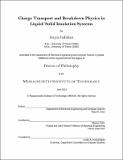| dc.contributor.advisor | Markus Zahn. | en_US |
| dc.contributor.author | Jadidian, Jouya | en_US |
| dc.contributor.other | Massachusetts Institute of Technology. Department of Electrical Engineering and Computer Science. | en_US |
| dc.date.accessioned | 2013-11-18T17:36:17Z | |
| dc.date.available | 2013-11-18T17:36:17Z | |
| dc.date.copyright | 2013 | en_US |
| dc.date.issued | 2013 | en_US |
| dc.identifier.uri | http://hdl.handle.net/1721.1/82178 | |
| dc.description | Thesis (Ph. D.)--Massachusetts Institute of Technology, Dept. of Electrical Engineering and Computer Science, 2013. | en_US |
| dc.description | This electronic version was submitted by the student author. The certified thesis is available in the Institute Archives and Special Collections. | en_US |
| dc.description | Cataloged from student-submitted PDF version of thesis. | en_US |
| dc.description | Includes bibliographical references (p. 223-230). | en_US |
| dc.description.abstract | Liquid dielectrics provide superior electrical breakdown strength and heat transfer capability, especially when used in combination with liquid-immersed solid dielectrics. Over the past half-century, there has been extensive research characterizing "streamers" in order to prevent them, as they are the main origins of electrical breakdown in liquid dielectrics. Streamers are conductive structures that form in regions of liquid dielectrics that are over-stressed by intense electric fields. Streamers can transform to surface flashovers when they reach any liquid-immersed solid insulation. Surface flashovers usually propagate faster and further than streamers in similar electric field intensity. Charge generation and transport is crucially important in liquid dielectric breakdown, since without the presence of the electric charge and its ability to migrate in the liquid dielectric volume and on the interface of liquid/solid dielectrics, streamers and surface flashovers are unable to develop. In this thesis, we develop a finite element method transport model in one, two and threedimensional geometries to help understand the complicated dynamics of electric charge transport and streamer breakdown in liquid dielectrics. This electrohydrodynamic model clarifies many of the mechanisms behind streamer/surface flashover formation, propagation and branching in typical liquid/solid dielectric composite systems. Several key mechanisms have been identified and added to the transport model of streamers, such as effects of electric field intensity on the ionization potential of liquid dielectric molecules and electron velocity saturation, which make the modeling results more realistic. In addition to improving the understanding of electrical breakdown physics in liquid-based insulation systems, a significant effort is made throughout this thesis research to enhance the stability, convergence, speed and accuracy of the model, making it a convenient and reliable tool for designing high voltage components that contain pure liquid dielectrics, nanofluids and liquid immersed insulation systems. This model, for the first time, is able to treat any given electrode shape and gap distance as well as any applied voltage waveform with accurate results, which provides a convenient preliminary way to verify the performance of an insulation system in terms of breakdown voltage, time to breakdown, electric field intensity distribution and ionization level. The model precision is validated through experimental records, analytical solutions and alternative modeling approaches wherever available. Specifically, we verify our one-dimensional numerical results with exact analytical solutions, and our two and three-dimensional modeling results with experimental data found in the literature or provided by ABB Corporate Research, Sweden. The streamer initiation voltages, number of streamer branches, breakdown voltages and currents are in excellent agreement with the experimental data compared to the prior theoretical research on liquid breakdown physics. Identical results obtained using a finite volume method also confirm the correctness of the finite element approach used in this thesis. The presented model can be employed to search for novel configurations of liquid immersed insulation systems including nanofluids and liquid/solid composite systems. | en_US |
| dc.description.statementofresponsibility | by Jouya Jadidian. | en_US |
| dc.format.extent | 230 p. | en_US |
| dc.language.iso | eng | en_US |
| dc.publisher | Massachusetts Institute of Technology | en_US |
| dc.rights | M.I.T. theses are protected by
copyright. They may be viewed from this source for any purpose, but
reproduction or distribution in any format is prohibited without written
permission. See provided URL for inquiries about permission. | en_US |
| dc.rights.uri | http://dspace.mit.edu/handle/1721.1/7582 | en_US |
| dc.subject | Electrical Engineering and Computer Science. | en_US |
| dc.title | Charge transport and breakdown physics in liquid/solid insulation systems | en_US |
| dc.type | Thesis | en_US |
| dc.description.degree | Ph.D. | en_US |
| dc.contributor.department | Massachusetts Institute of Technology. Department of Electrical Engineering and Computer Science | |
| dc.identifier.oclc | 861704007 | en_US |
